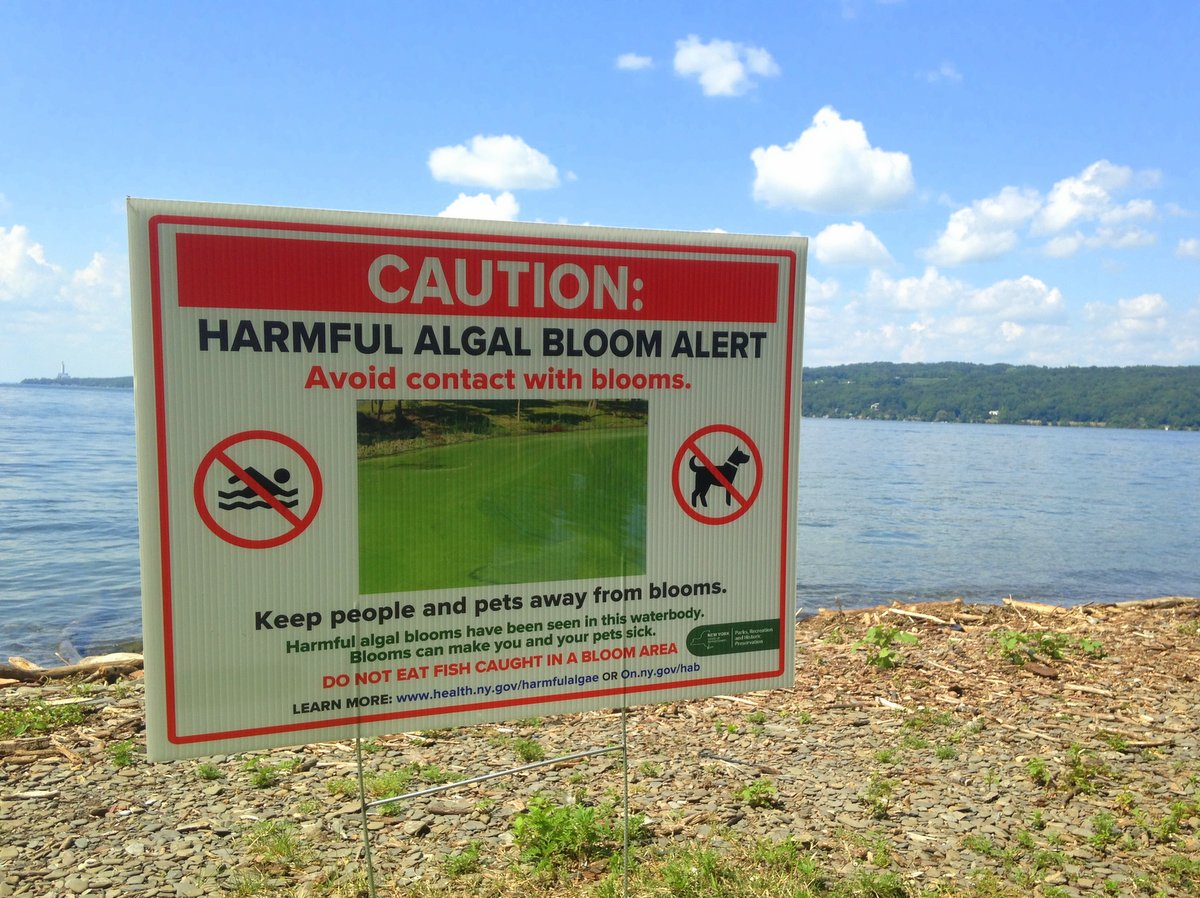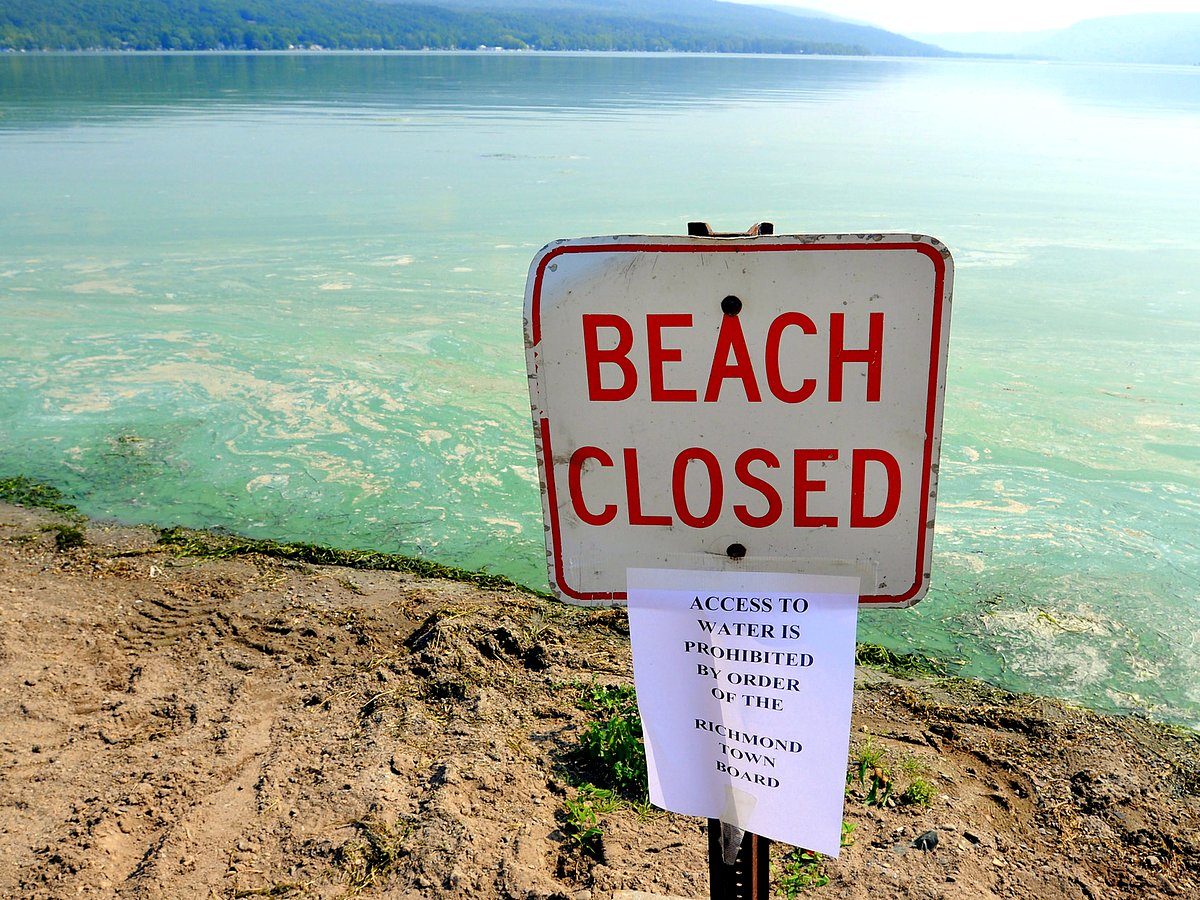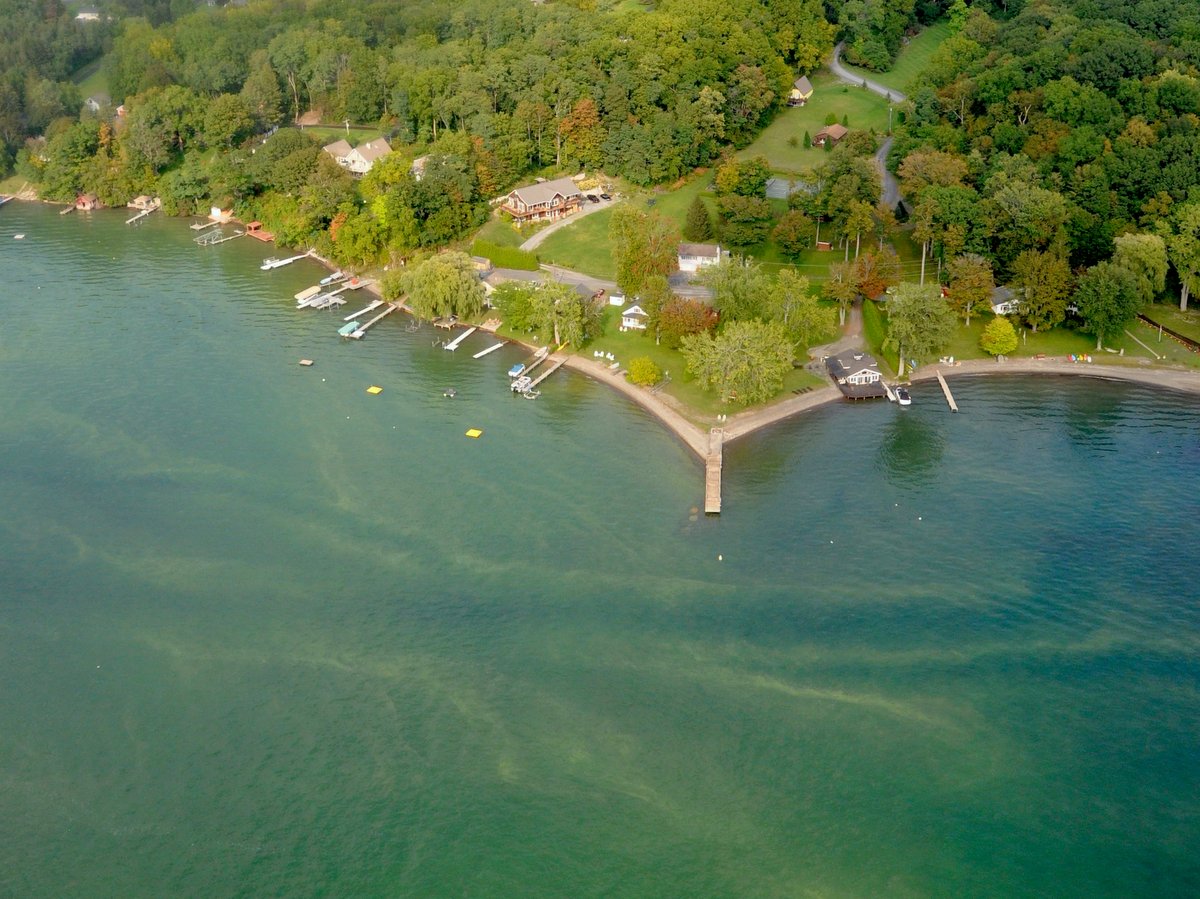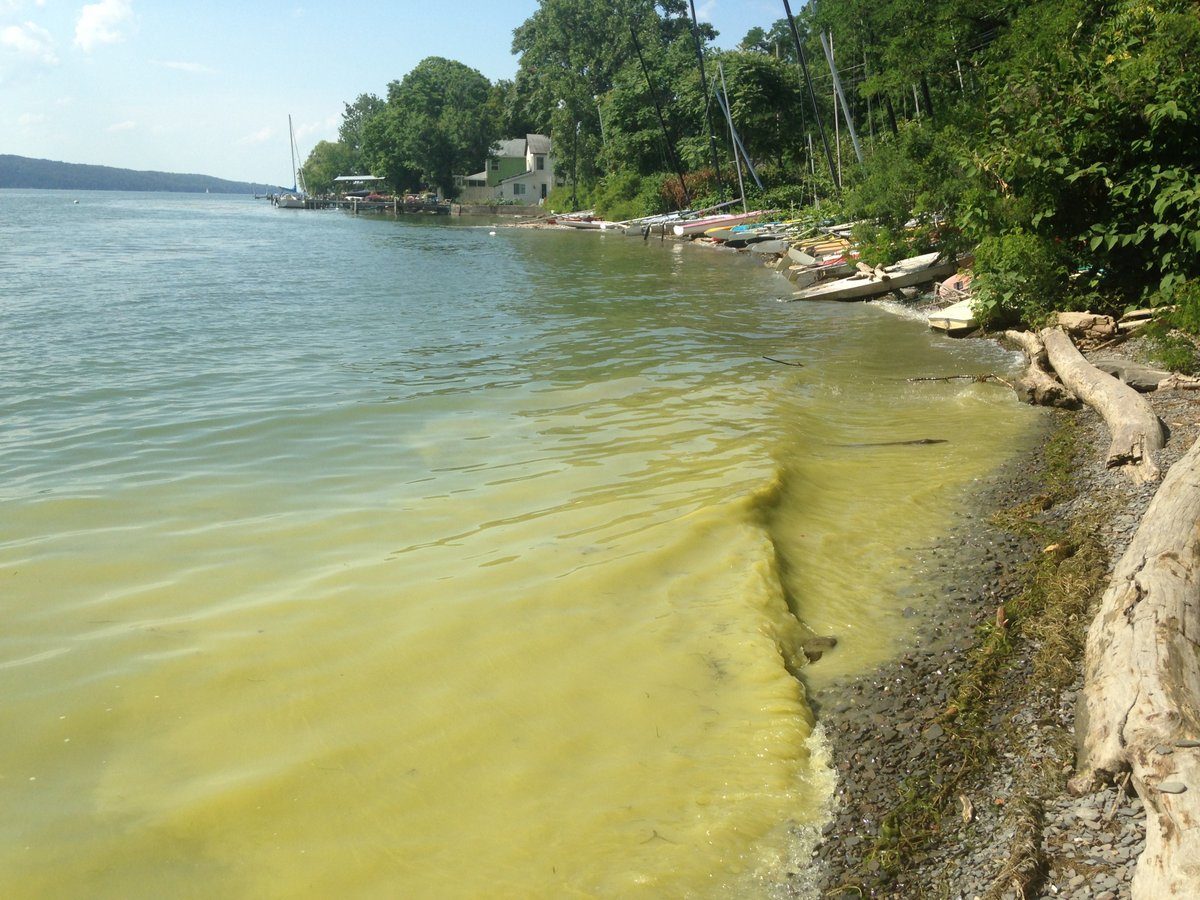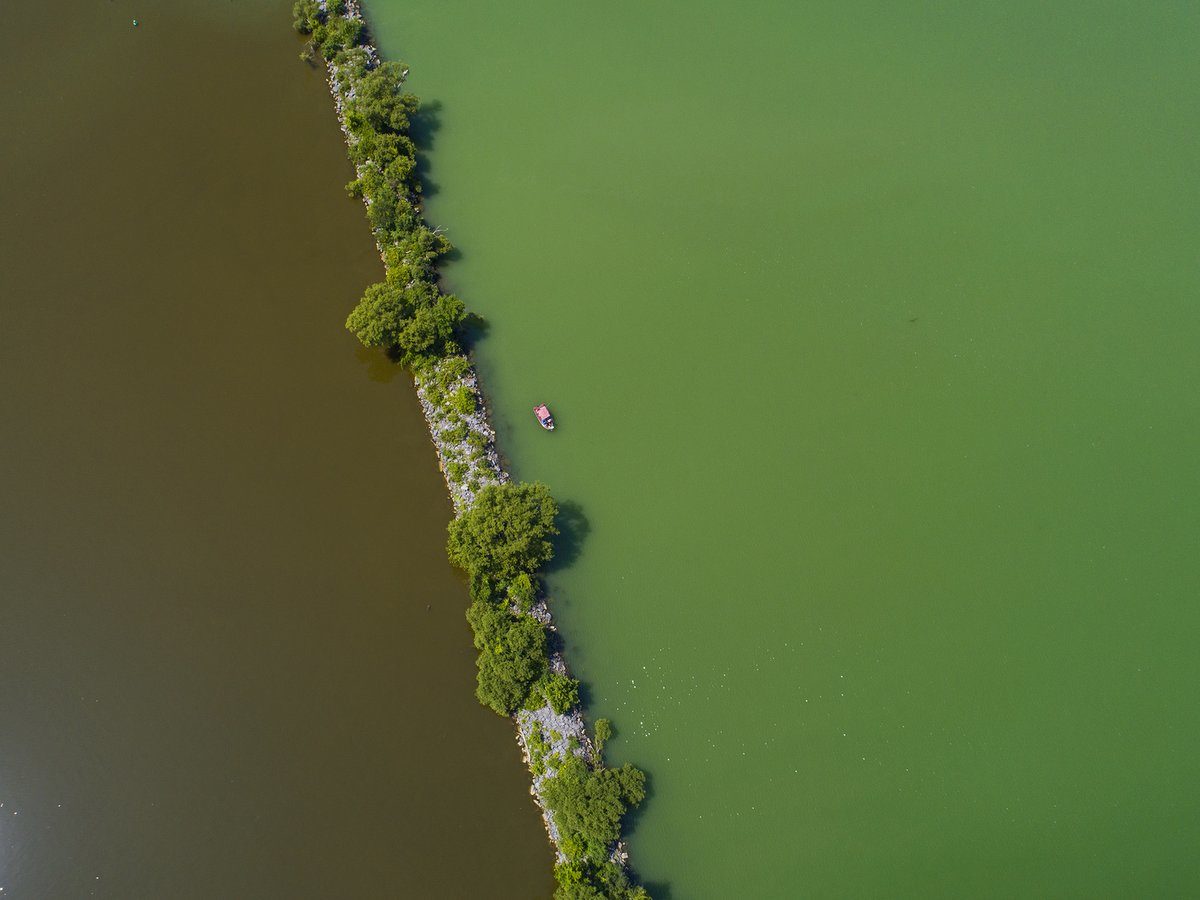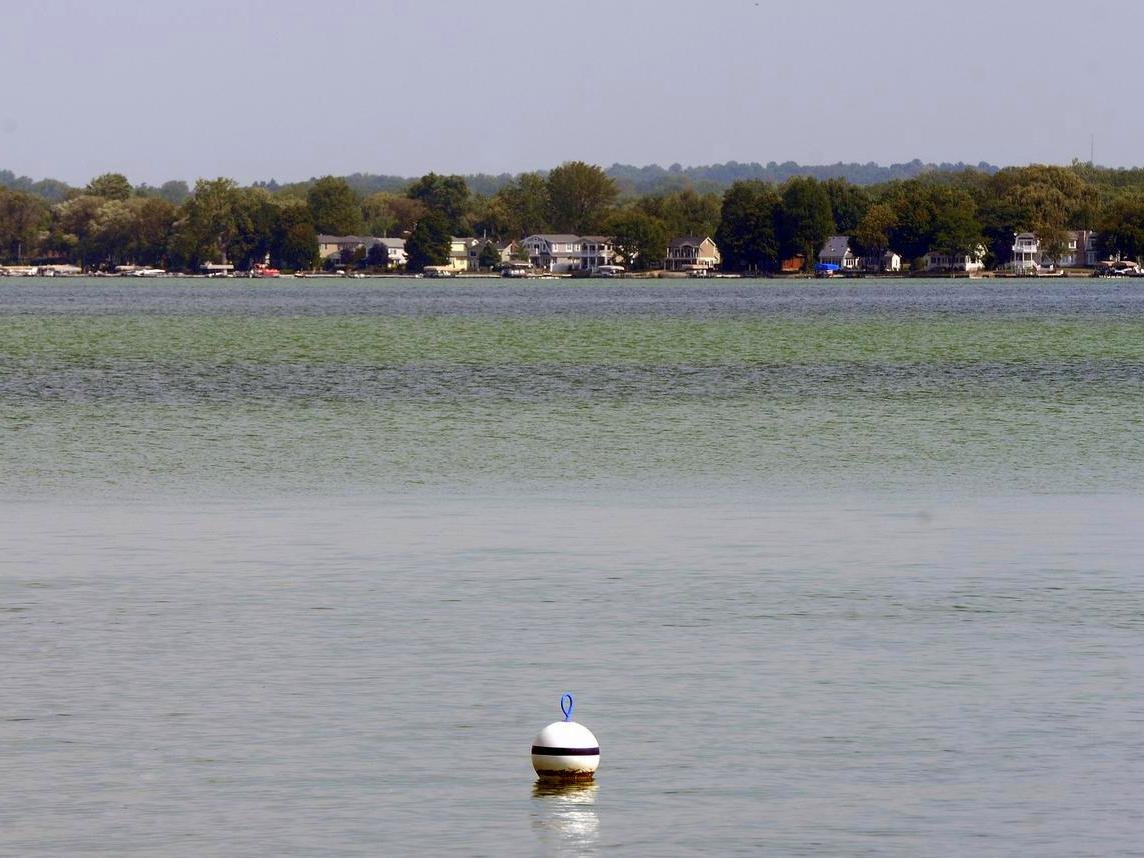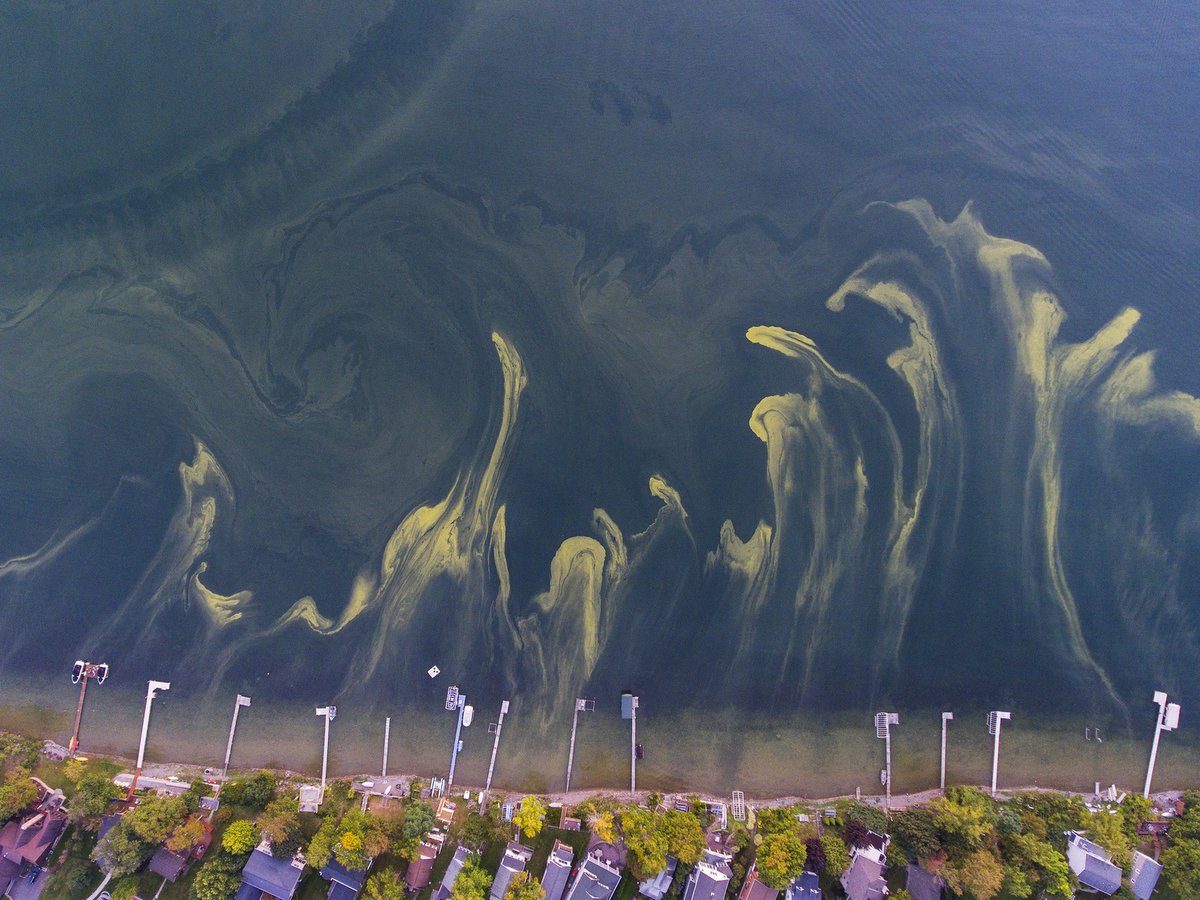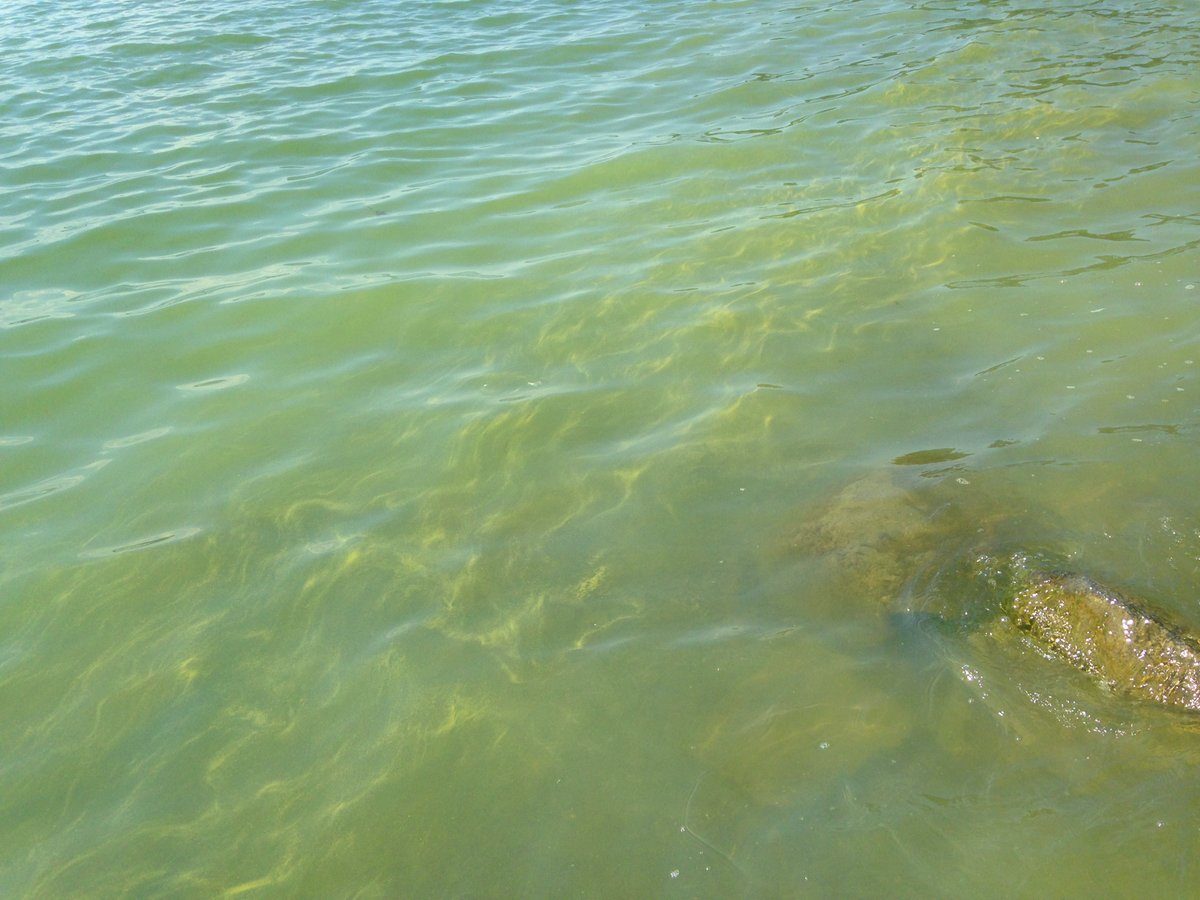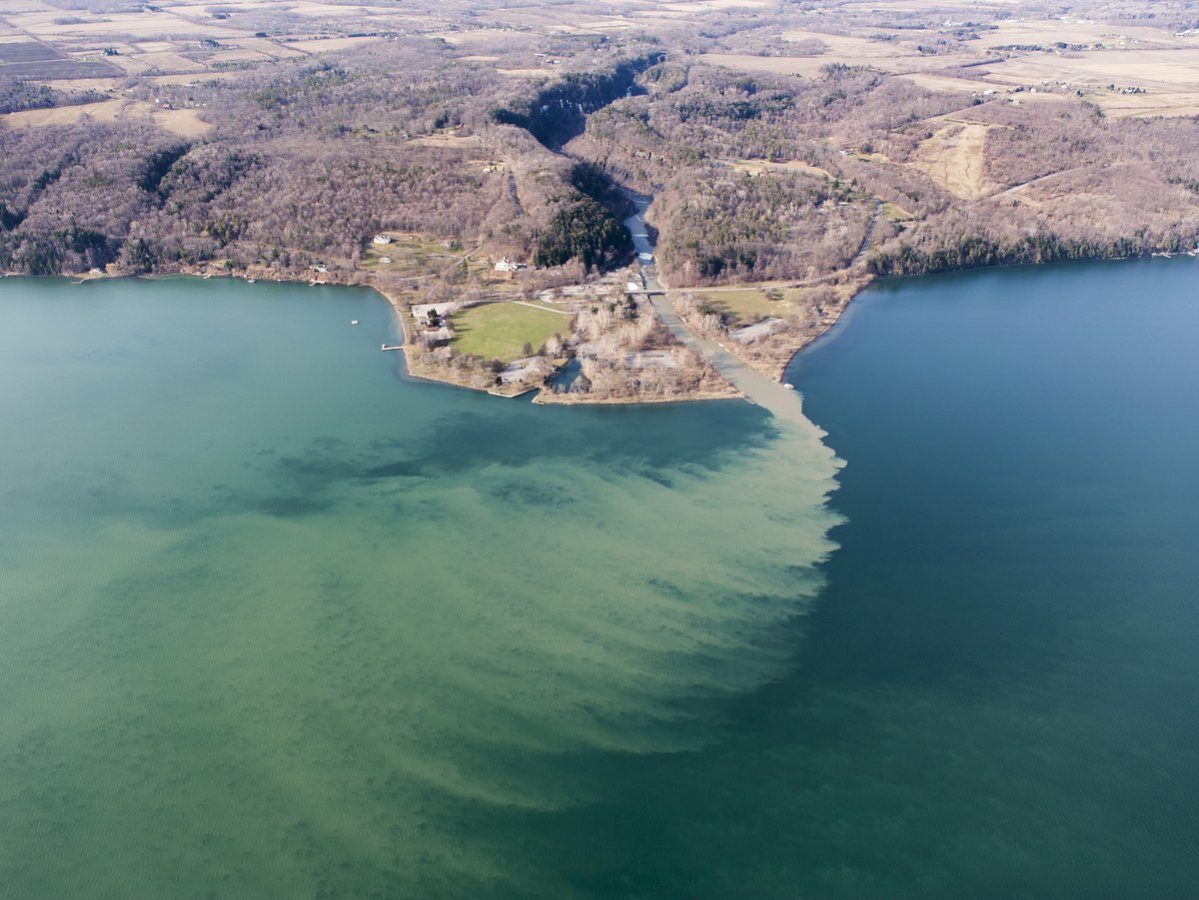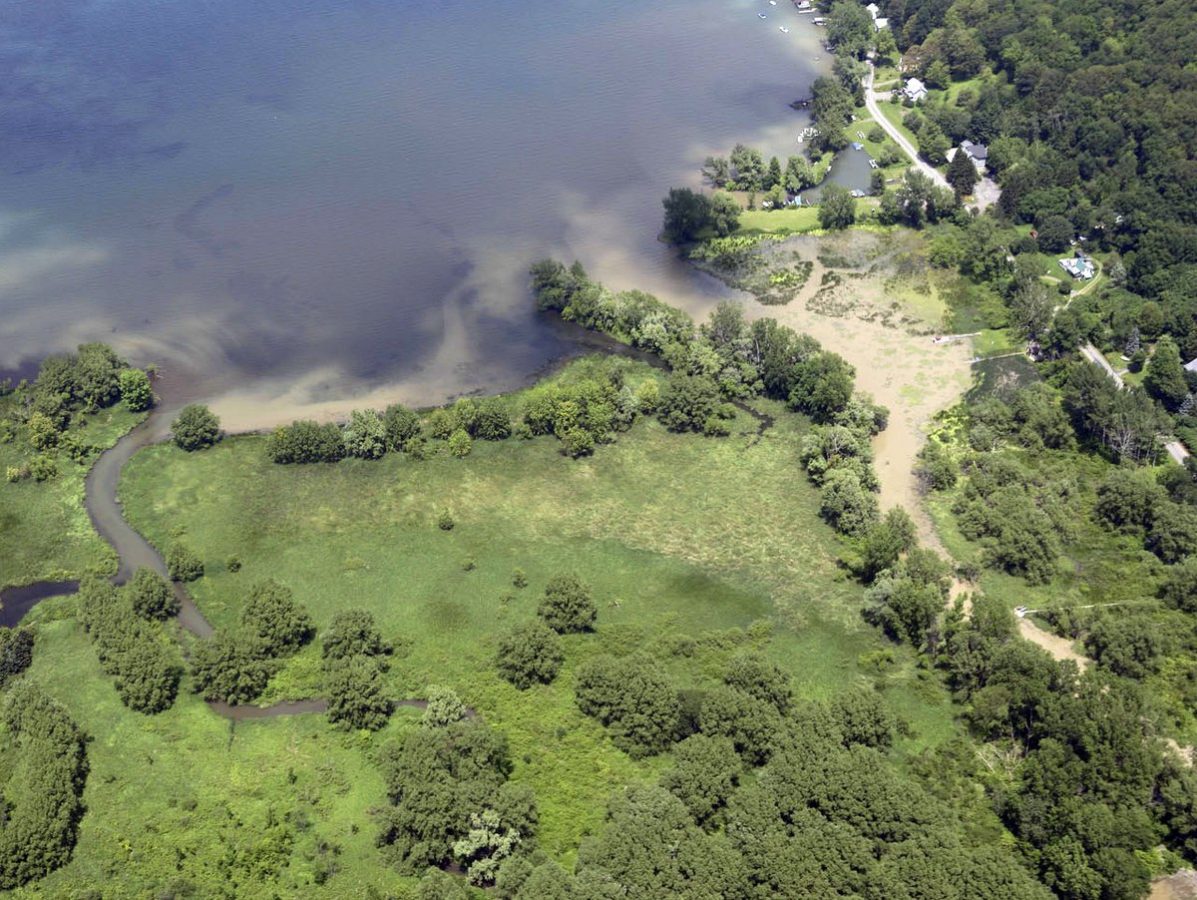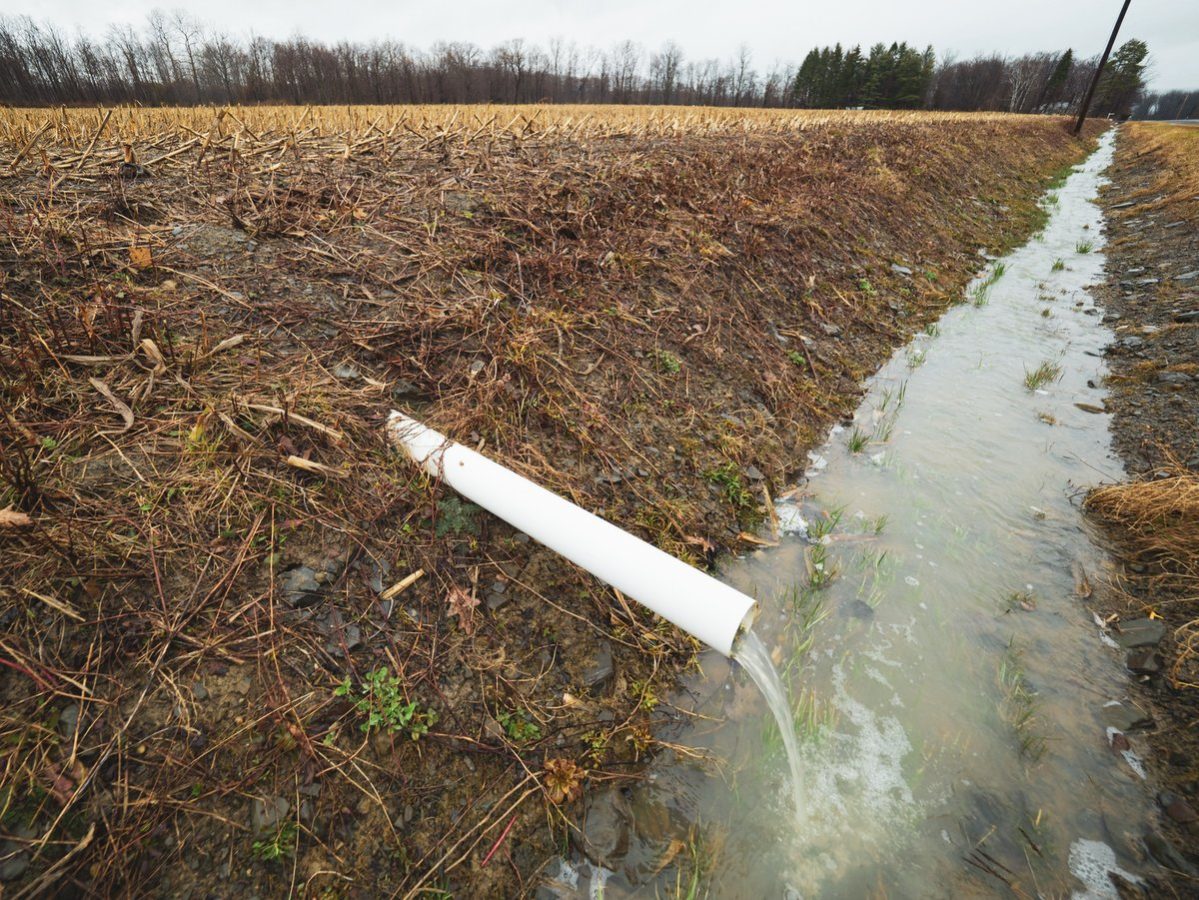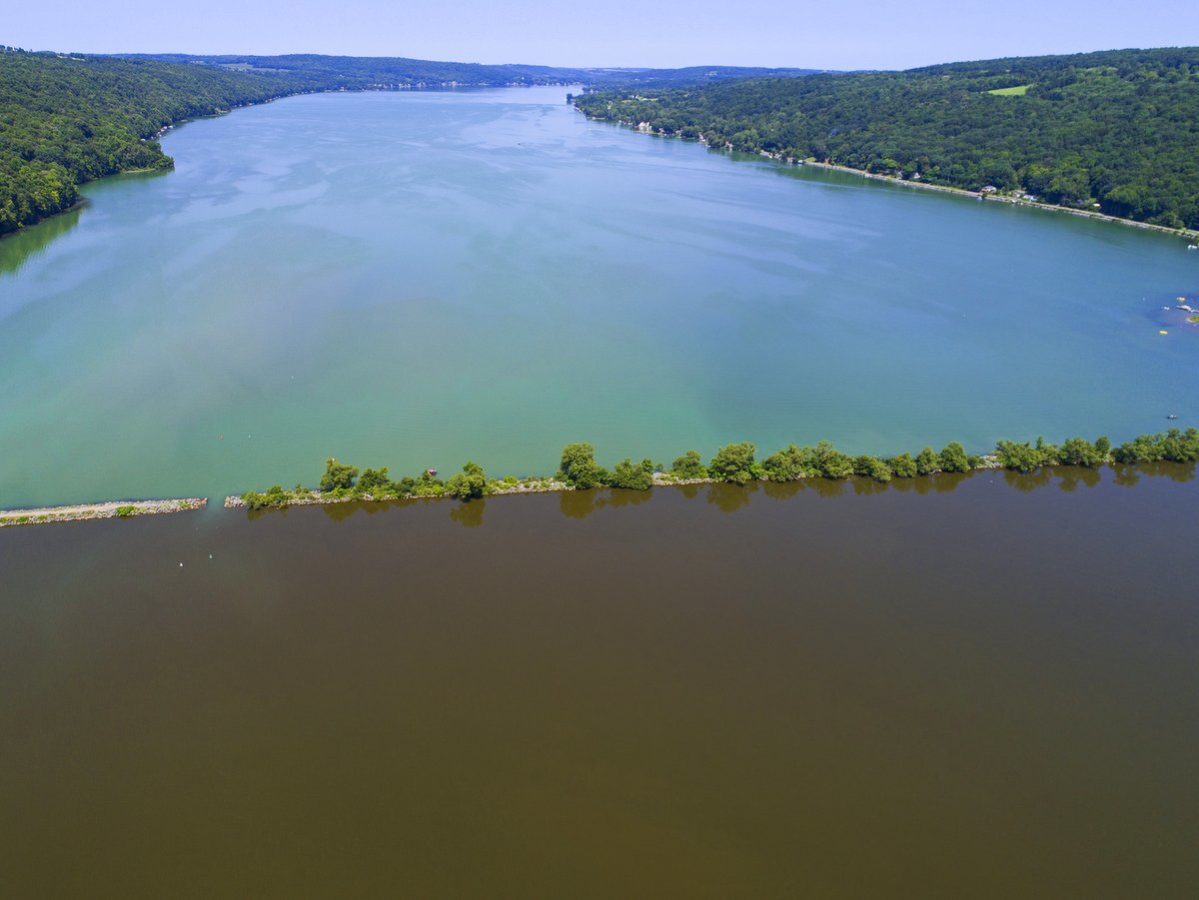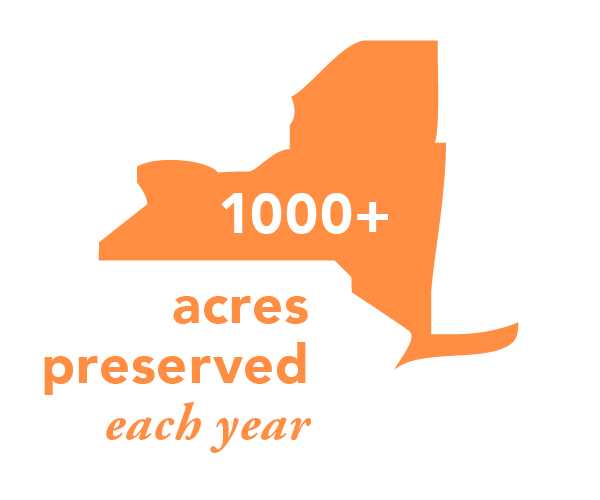‘Toxic algae’ and ‘harmful algal bloom’ (HAB) are colloquial terms for cyanobacteria, a naturally occurring organism which can cause serious human and animal health effects when outbreaks occur in drinking water supplies and swimming areas.
In recent years, outbreaks have occurred in all 11 Finger Lakes, and many water bodies worldwide, signaling an increasing threat to public health, local economies, and quality of life. Here we share basic facts about toxic algae – what is known and what is yet to be understood.
Please see our Toxic Algae Resources page to learn more.
- Taughannock Falls State Park closed swimming areas multiple times owing to toxic algae outbreaks. Photo: Jeff Katris
- A toxic algae outbreak forced the closure of a town beach at Sandy Bottom Park, Honeoye Lake. Photo: Jack Haley/Messenger Post
- Sweeping strands of harmful algal blooms were spotted near private lakefront residences on Skaneateles Lake. Photo: Nigel Moll
- A harmful algal bloom at a popular public gathering spot on the east shore of Cayuga Lake in Ithaca. Photo: Jeff Katris
Facts
What is toxic algae?
When people say “toxic algae” or “blue-green algae,” they are referring to cyanobacteria – microscopic organisms that live in water bodies but are usually not populated in sufficient density to be noticed by humans. When cyanobacteria grow in a concentrated area, it is often called a “harmful algal bloom,” “harmful aquatic bloom,” or “HAB.” Blooms can be visually distinctive, appearing like neon-green paint or pea soup that has been poured across a water surface; but, blooms can be less conspicuous, faintly visible as floating particles or strands in the water.
Why is it called ‘toxic’ algae?
Some species of cyanobacteria produce toxins while others do not, and risks vary depending on the species of bacteria and the type of toxin. Cyanobacteria release toxins as their cells grow and break down, and the toxins can persist even after a bloom has disappeared.
Some of the most common cyanotoxins in the United States are microcystins, cylindrospermopsin, anatoxins and saxitoxins. Microcystins are a liver toxin, and can also affect kidneys and reproductive systems, and can irritate the skin, eyes, and throat. Cylindrospermopsin is toxic to the liver and kidneys. Anatoxins are neurotoxins, and affect the central nervous system.
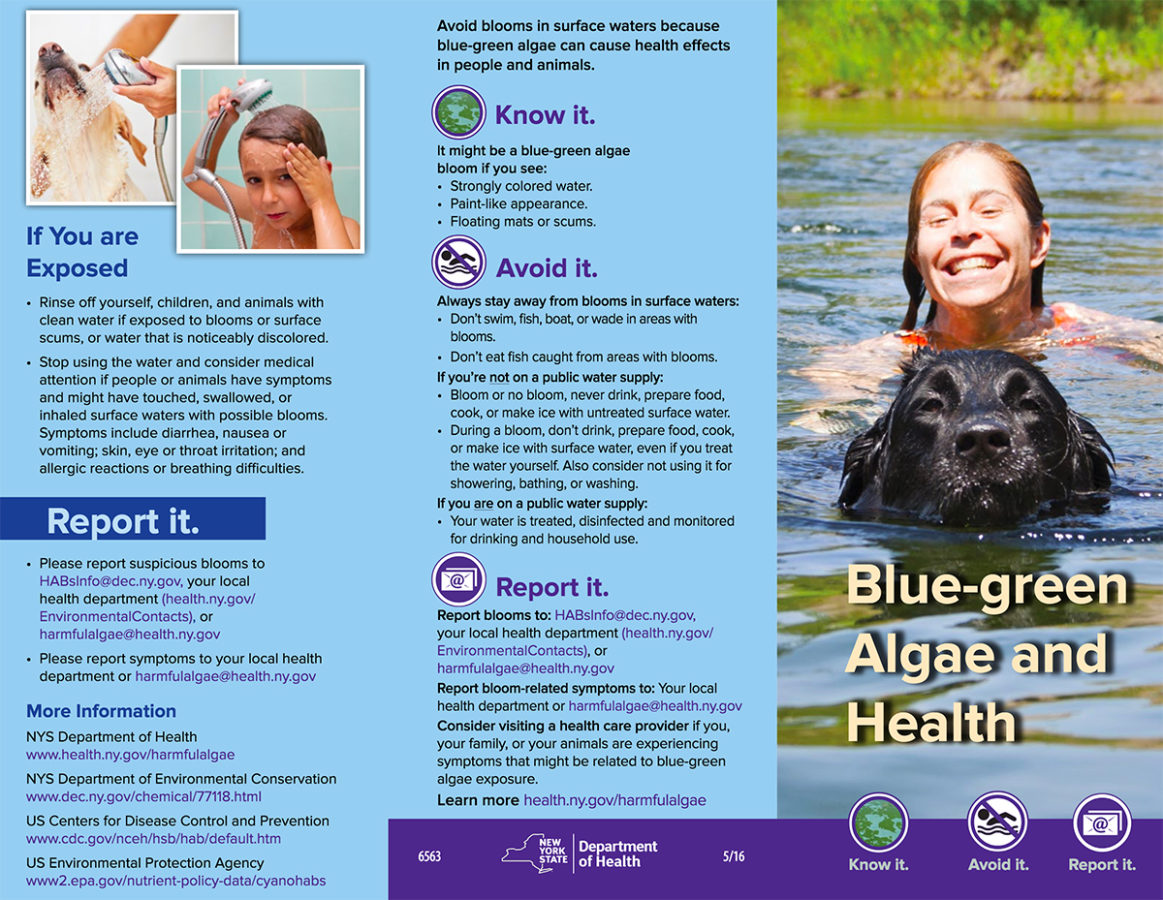 NYS DOH “Blue-Green Algae and Health” Brochure (PDF)
NYS DOH “Blue-Green Algae and Health” Brochure (PDF)
Who is affected and why does it matter?
Toxic algae poses risks to people and pets who come into contact with the water either through recreation or household use such as drinking and bathing. Using surface water that has not been provided by a public water system can lead to exposure, as some household methods of treatment such as water filtration or chlorine may not remove cyanotoxins. People who have been exposed to toxic algae can exhibit symptoms such as headaches, skin irritation, allergic reactions, stomach cramps, and vomiting.
Pets, especially dogs that play in blooms, can be fatally sickened very quickly. Such accidents have appeared in national news:
- Algae That Can Kill Dogs Is Discovered in 3 N.Y.C. Parks – New York Times
- Algae Can Poison Your Dog – New York Times
- Three Dogs Die from Toxic Algae in North Carolina – CNN
See Dogs and Harmful Algal Blooms (PDF) from the New York Sea Grant Extension Program.
There can also be economic impacts of frequent and long-lasting blooms, since beaches and shorelines may be closed for significant portions of the outdoor season, limiting recreational and tourism opportunities like boating, fishing, and swimming.
Where and when do outbreaks occur?
Toxic algae blooms occur in water bodies across the country. Since 2017, each of the 11 Finger Lakes has experienced at least one outbreak of toxic algae, and for most of our lakes it has become a regular, annual occurrence. They are most common in the summer and early fall, when warm temperatures, calm water, and plentiful sunlight make the water conditions ideal for cyanobacteria to grow.
Please see the interactive map at NYHABS, hosted by the Department of Environmental Conservation, for the location of freshwater blooms reported in New York State during the current calendar year. See our Toxic Algae Resources page for an introduction to NYHABS.
- Large suspected bloom, Otisco Lake. Photo: Matt Champlin
- Offshore bloom, Canandaigua Lake. Photo: Jack Haley/Messenger Post
- Extensive strands on Owasco Lake. Photo: Matt Champlin
- Localized strands on Cayuga Lake shoreline. Photo: Jeff Katris
How do I know if I am seeing a toxic outbreak?
Toxic algae blooms can take many appearances, varying from a solid surface covering – like spilled paint or pea soup – to strands, clumps, or dots. Colors can include shades of green, blue-green, yellow, brown, red, or white. See the DEC HABs photo gallery. You cannot confirm a harmful bloom by visual inspection alone. Only a water test can confirm the presence of toxins.
From the DEC brochure: “It can be hard to tell a harmful bloom from a non-harmful algal bloom, so it is best to avoid swimming, boating, fishing or other recreation in discolored water that looks like it might have a bloom. Avoid eating fish caught from areas with a bloom. Never drink, prepare food, cook, or make ice with untreated surface water, even if there is no visible bloom.”
What should I do if I spot an outbreak?
If you suspect that you have seen a harmful algal bloom, report it to NYS DEC by submitting the Suspicious Algal Bloom Report Form. Attach digital photos (close-up and landscape to show extent and location) of the suspected HAB in the web form. Email HABsInfo@dec.ny.gov if you are not able to complete the form.
Why does it happen?
While research into the specific causes of outbreaks in our region is still underway, there is growing consensus that excessive nutrients from agricultural fields, as well as roadside ditches, poorly maintained septic systems, and other sources, all play an important role.
High nutrient levels in water, sunlight, warm temperatures, and calm water can provide ideal growing conditions for bacteria, and occur with increasing frequency due to the effects of climate change (NOAA). Heavy storms can channel nutrients into the water, and increasingly warm temperatures create favorable conditions for toxic algae (EPA).
Nutrients such as nitrogen and phosphorus are used increasingly as fertilizers for landscaping and agriculture, and heavy rain causes runoff and erosion that directs these nutrients into nearby waterbodies. Failing septic systems and manure from livestock, particularly near lakeshores or streams, can add additional nutrients to the water.
This flush of nutrients, followed by warm, calm weather, can trigger the excessive cyanobacterial growth that leads to a toxic algae bloom.
Additionally, research is pointing to invasive mussel species as a potential contributing factor as zebra and quagga mussels can influence phytoplankton composition by selectively filter feeding phytoplankton, which can result in increased prevalence of cyanobacteria.
- Runoff from Taughannock Creek into Cayuga Lake. Photo: Bill Hecht
- Runoff into Skaneateles Lake at Grout Brook. Photo: Bill Hecht
- Agricultural nutrient loading into roadside ditches. Photo: Chris Ray
- Otisco Lake runoff and suspected bloom. Photo: Matt Champlin
What can we do about toxic algae?
Please see our page, “Actions We All Must Take Together to Fight Toxic Algae.”
Reducing nutrients and runoff into waterbodies is an essential step to preventing and reducing toxic algae blooms. Inspecting and maintaining septic tanks and limiting or eliminating fertilizer use on lawns and agricultural fields are important ways to minimize the amount of nutrients on the landscape.
Pairing nutrient reduction with increased tributary and shoreline buffers can help minimize nutrient loading into the lakes. Buffers can be made up of a variety of species of trees, shrubs, and groundcover and help to retain and filter water into soil and the roots of plants rather than running directly from a field, pasture, pavement, or lawn into a waterbody.
On the global scale, a systematic and robust effort is also needed to address and mitigate climate change – with a particular emphasis on reducing our greenhouse gas emissions and accelerating our transition from fossil fuels to renewable energy sources.
And locally, additional research is required to better understand the degree to which different factors contribute to the occurrence of toxic algae outbreaks in our region and to identify the most effective strategies for addressing them.
How is the Finger Lakes Land Trust (FLLT) helping?
Please see our page, “How is the Finger Lakes Land Trust Fighting Toxic Algae?”
Also consult these pages on our Water Quality hub:
- Our New 5-Point Initiative for Immediate Action to Protect Water
- Our Projects to Save Lakes, Streams, and Drinking Water
- Three Nonprofits Join Forces in Skaneateles Watershed
- “Lakes, Farms, and Forests Forever”
By working cooperatively with landowners and local communities, the Finger Lakes Land Trust has protected more than 31,000 acres of the region’s undeveloped lakeshore, rugged gorges, rolling forests, and scenic farmlands. As of 2019, the Land Trust owns and manages a network of over 35 nature preserves that are open to the public and holds perpetual conservation easements on 146 properties that remain in private ownership.
The Land Trust focuses on protecting critical habitat for fish and wildlife, conserving lands that are important for water quality, connecting existing conservation lands, and keeping prime farmland in agriculture. The organization also provides programs to educate local governments, landowners, and local residents about conservation and the region’s unique natural resources.
We work with partners to protect and restore shoreline and riparian buffers, create wetlands to retain water on the landscape, and promote best practices for water quality on any lands that we own or protect with a conservation easement.
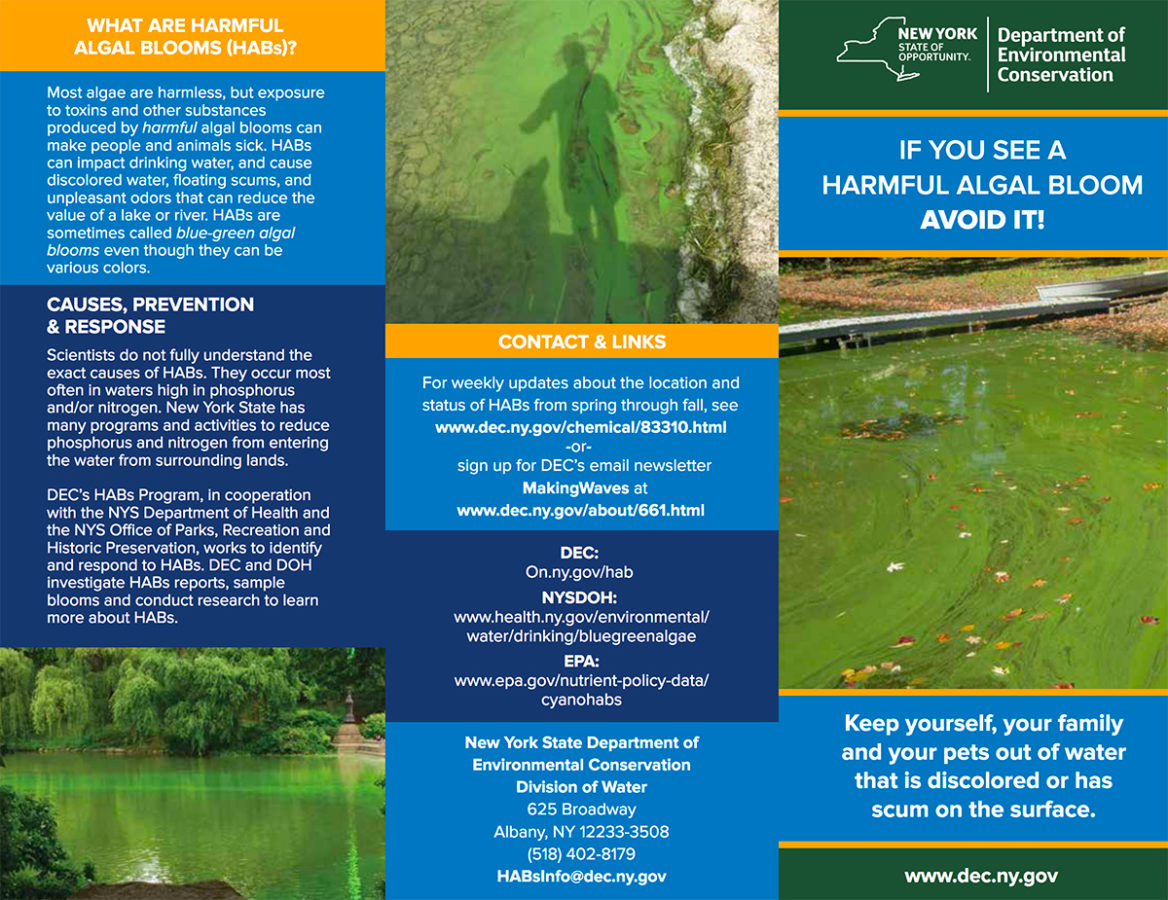 NYS DEC “If You See a Harmful Algal Bloom” Brochure (PDF)
NYS DEC “If You See a Harmful Algal Bloom” Brochure (PDF)
Who else is working on the solution?
Please see Toxic Algae Resources for links to government agencies, and Our Partners in Water Quality Protection for lake associations and other organizations that are working to counter the threat of toxic algae.
How can I learn more about toxic algae in the Finger Lakes?
Please see Toxic Algae Resources. Sources that were consulted for this Basic Facts page include: Microcystins – EPA; Learn about Cyanobacteria and Cyanotoxins – EPA; Cyanobacterial toxins: Microcystin-LRin Drinking-water – WHO (PDF); Drinking Water Treatability Database – EPA; Climate Change and Harmful Algal Blooms – EPA; What Is a Harmful Algal Bloom? – NOAA.
ACT NOW
Help the Land Trust protect more land and water forever
Make your gift to the Finger Lakes Land Trust to advance our work protecting sensitive lands and waters, and increasing regional public awareness of the toxic algae threat.

